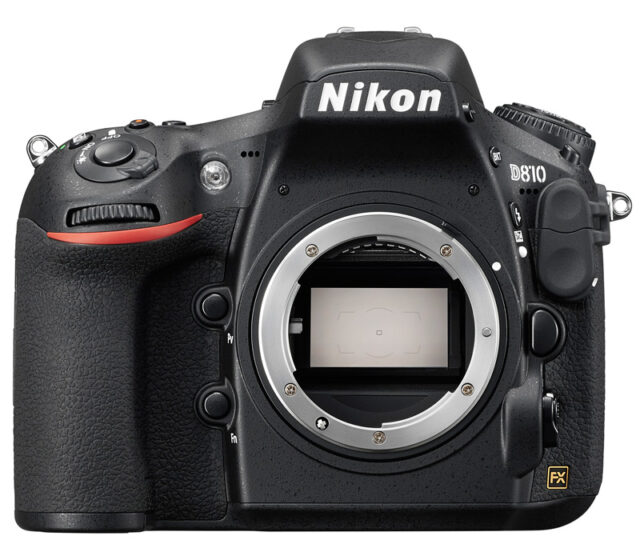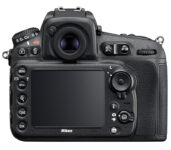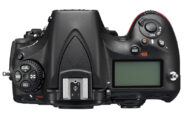Announced
System
Nikon F system cameras
- Nikkorex F
- Nikkormat EL
- Nikkormat ELW
- Nikkormat FS
- Nikkormat FT
- Nikkormat FT2
- Nikkormat FT3
- Nikkormat FTN
- Nikon D3
- Nikon D3s
- Nikon D3X
- Nikon D4
- Nikon D4s
- Nikon D5
- Nikon D6
- Nikon D600
- Nikon D610
- Nikon D700
- Nikon D750
- Nikon D780
- Nikon D800
- Nikon D800E
- Nikon D810
- Nikon D850
- Nikon Df
- Nikon EL2
- Nikon EM
- Nikon F
- Nikon F100
- Nikon F2
- Nikon F3
- Nikon F4
- Nikon F5
- Nikon F6
- Nikon FA
- Nikon FE
- Nikon FE10
- Nikon FE2
- Nikon FG
- Nikon FG-20
- Nikon FM
- Nikon FM10
- Nikon FM2
- Nikon FM2/T
- Nikon FM3A
- Nikon N2000
- Nikon N2020
- Nikon N4004
- Nikon N4004S
- Nikon N50
- Nikon N5005
- Nikon N55
- Nikon N60
- Nikon N6000
- Nikon N6006
- Nikon N65
- Nikon N70
- Nikon N75
- Nikon N80
- Nikon N8008
- Nikon N8008S
- Nikon N90
- Nikon N90S
Nikon D810
35mm AF digital SLR camera
Specification
| Format: | |
| 35mm full frame | |
Imaging sensor: | 35.9 × 24mm CMOS sensor |
Resolution: | 7360 × 4912 - 36 MP |
Sensor-shift image stabilization: | - |
| Nikon F [46.5mm] | |
| Shutter: | |
Type: | Focal-plane |
Model: | Electronically controlled |
Speeds: | 30 - 1/8000 + B |
| Exposure: | |
Exposure metering: | Through-the-lens (TTL), open-aperture |
Exposure modes: | Programmed Auto |
| Aperture-priority Auto | |
| Shutter-priority Auto | |
| Manual | |
| Physical characteristics: | |
Weight: | 980g |
Dimensions: | 146x123x81.5mm |
Manufacturer description
TOKYO - Nikon Corporation is pleased to announce the release of the D810, a Nikon FX-format digital SLR camera.
The D810 is a digital SLR camera that boasts incredibly superior definition and image quality made possible with a new Nikon FX-format CMOS sensor with no optical low-pass filter, adoption of the latest EXPEED 4 image-processing engine, an effective pixel count of 36.3-million pixels, and a standard range of sensitivities from ISO 64 to ISO 12800. Not only does it offer extremely accurate AF, but vibrations generated inside the camera have been reduced to maximize the resolution of its 36.3-million pixels for sharp and clear images. The camera also supports recording of smooth, extremely sharp 60p full-HD (1920 x 1080) movies. What's more, high-speed continuous shooting at up to 5 fps with the FX-format image area and up to 7 fps* with the DX-format image area is possible for excellent response to a wide variety of scenes.
D810 Development Background
The D800 and D800E, added to Nikon's lineup of Nikon FX-format cameras in March 2012, drew great attention from professional and advanced amateur photographers as digital SLR cameras offering superior image quality nearly equal to that of medium-format cameras. The performance of these two cameras was well received around the world, earning them a number of prestigious awards, including a respected Technical Image Press Association (TIPA) Award 2012 and a European Imaging and Sound Association (EISA) Photo Award presented to the D800.
Developed with this background, the D810 offers the best image quality in the history of Nikon, as well as functions that increase the certainty and reliability of this superior image quality, to respond to the expectations of photographers who demand superior clarity, sharpness, and image quality from their photos.
D810 Primary Features
1. The first digital SLR camera in Nikon's history to offer a minimum standard sensitivity of ISO 64 at which superior clarity and image quality with rich tones is achieved
A minimum standard sensitivity of ISO 64, at which the same broad dynamic range available with ISO 100 is possible, was achieved through the adoption of a new FX-format CMOS sensor and by increasing the volume of light information that can be accumulated. This enables suppression of loss of detail in highlights (blown highlights) and beautiful rendering of subjects with rich tones, even when a fast lens is used in bright surroundings. In addition, collaboration with the same EXPEED 4 image-processing engine adopted for the D4S achieves a broad range of standard sensitivities up to ISO 12800 (Lo 1, Hi 1, and Hi 2 settings are also available).
2. Further increases in imaging flexibility: The Picture Control system, Nikon's exclusive advanced system for image processing
A new "Flat" Picture Control option has been added with the D810. Less in-camera processing is applied to images captured at a Picture Control setting of "Flat" than to those captured at a setting of "Neutral", enabling maximization of the amount of subject information acquired. The "Flat" setting prevents loss of detail in highlights and shadows, as well as over-saturation of colors, enabling adjustment of image quality and post-processing for richer tone characteristics, including contrast and colors. In addition, a "Clarity"*1 option has been added to adjustment settings for each Picture Control, allowing users to make images sharper or softer without over-emphasizing outlines and edges in images, and each setting can be adjusted in increments of 0.25 step*2, enabling more precise adjustment that makes it easier to achieve imaging that better reflects user intent.
3. Extremely precise AF and superior vibration suppression that maximize the resolution of the 36.3-million-pixel effective pixel count
In order to make the most of the incredibly high pixel count of 36.3-million effective pixels, the precision of the 51-point AF system has been increased with adoption of the Advanced Multi-CAM 3500FX autofocus sensor module and improvements to the focusing algorithm, ensuring exact autofocus acquisition on the intended portion of a still subject. In addition, mechanical operation of components such as the mirror and shutter has been improved for significant reduction in the amount of internal vibration generated. The end result is a system capable of maximizing the superior rendering performance of NIKKOR lenses and the superior definition of the D810's CMOS sensor.
4. High-speed continuous shooting at approximately 5 fps in FX format and approximately 7 fps* in DX format makes capture of a broader range of subjects possible
Adoption of a new CMOS sensor and the EXPEED 4 image-processing engine makes high-speed continuous shooting at approximately 5 fps in FX format and approximately 7 fps* in DX format possible with the D810. This makes capture of a broader range of subjects/scenes possible with excellent response with not only still subjects, but also moving subjects such as wildlife and sports scenes.
5. Full-HD movie recording with which picture quality and operation has been significantly improved
The full-HD movie recording function, capable of recording extremely sharp and clear movies exhibiting significantly fewer moiré patterns and jaggies, and less color aliasing, supports 60p recording for smoother expression of subject movement. In addition, operation has been improved with Auto ISO Sensitivity Control in M exposure mode, enabling exposure control with aperture value and shutter speed locked and automatic adjustment of only ISO sensitivity, as well as a highlight display that shows the brightest areas of the frame in which detail may be lost with display of slanted lines. Beautiful time-lapse movies with which variations in exposure between frames are controlled can also be generated in-camera.
D810 Additional Features
- An electronic front-curtain shutter that prevents blur in images with minimization of vibration resulting from the operation of mechanisms with shooting
- Highlight-weighted metering, with which exposure values that reduce loss of detail in highlights (blown highlights) are determined, convenient for capturing theater scenes and the like
- The first Nikon FX-format camera with an OLED viewfinder display; an optical viewfinder with frame coverage of approximately 100% that offers better light transmissivity and colors, and makes it easier to achieve the optimal focus when fast lenses are used
- A 1229k-dot LCD monitor with bright RGBW array equipped with the "Monitor color balance" function that allows users to adjust monitor colors
- A "Split-screen display zoom" function that displays enlarged views of two separate areas of the frame side-by-side for checking level if the building is aligned with the horizon with live view photography
- Advanced Scene Recognition System, which utilizes a 91K-pixel RGB sensor, for highly precise automatic control over auto exposure (AE), autofocus (AF), and auto white balance (AWB)
- RAW recording at an image size of "Small"
- Multi-area mode full-HD D-movie that allows users to choose between two movie formats (image areas), FX-based and DX-based
- Improved movie sound quality with "Wind noise reduction" and "Frequency response" ("Wide range"/"Vocal range") settings
- Optimal layout of operational controls, and a grip sized and shaped for a firm, steady hold even when large lenses are used
- Effective sealing for superior resistance to dust and water
Similar cameras (2)
35mm full frame • Auto focus • Digital • Singe-lens reflex • Nikon F mount
| Model | Shutter | Metering | Modes | Year |
|---|---|---|---|---|
| Kodak DCS Pro 14n | E, 1/4000 | TTL • OA | PASM | 2002 |
| Kodak DCS Pro SLR/n | E, 1/4000 | TTL • OA | PASM | 2004 |


